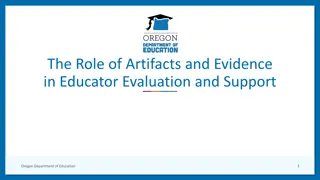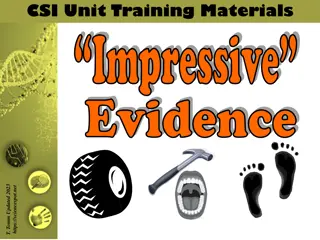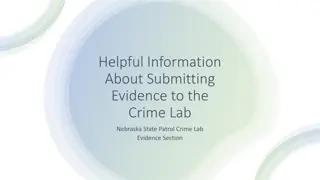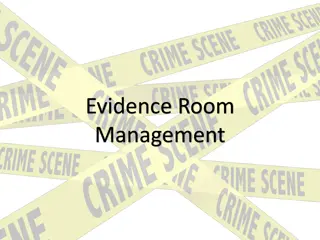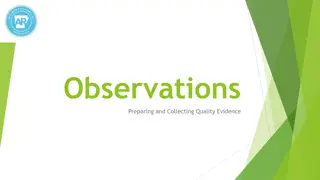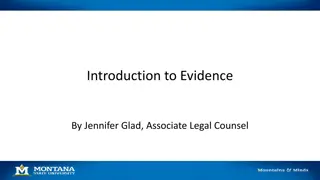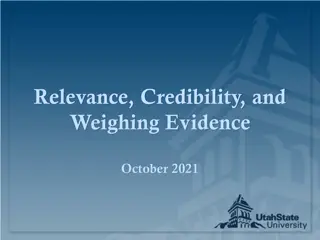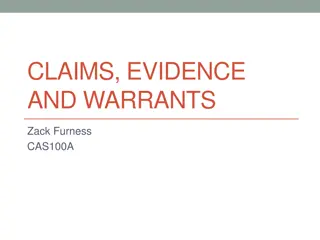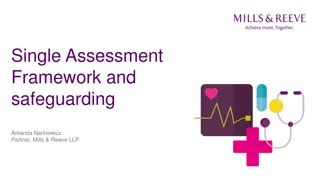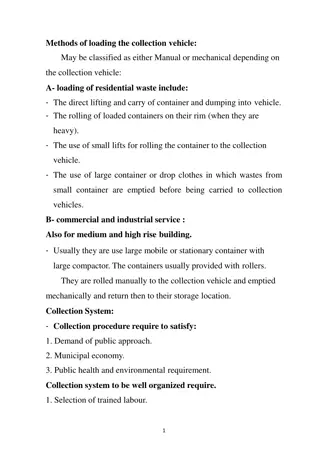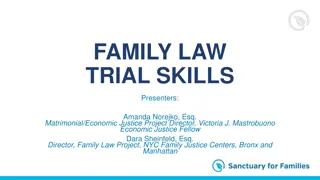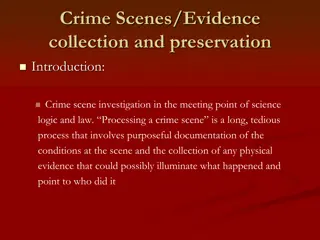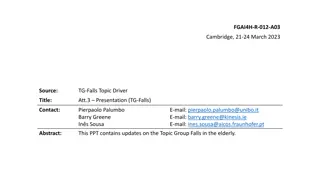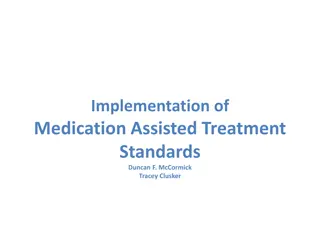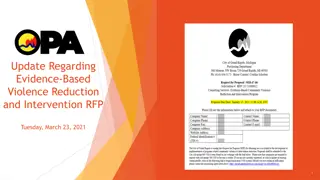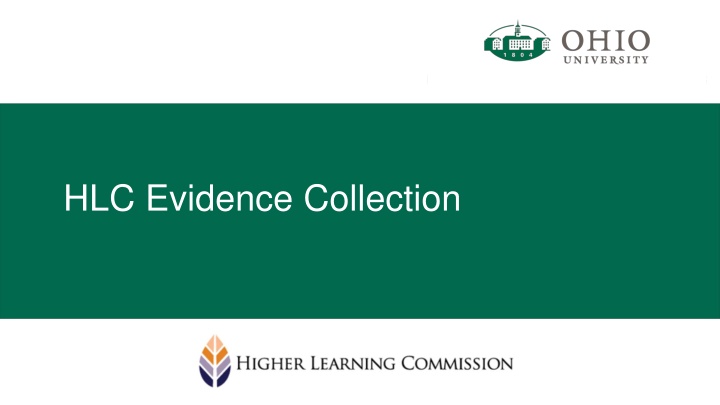
HLC Institutional Accreditation Process
Dive into the Higher Learning Commission (HLC) accreditation process for universities, exploring criteria, evidence collection, and pathways for assurance filings. Learn about the importance of institutional effectiveness and the stages of maturity in meeting accreditation standards.
Download Presentation

Please find below an Image/Link to download the presentation.
The content on the website is provided AS IS for your information and personal use only. It may not be sold, licensed, or shared on other websites without obtaining consent from the author. If you encounter any issues during the download, it is possible that the publisher has removed the file from their server.
You are allowed to download the files provided on this website for personal or commercial use, subject to the condition that they are used lawfully. All files are the property of their respective owners.
The content on the website is provided AS IS for your information and personal use only. It may not be sold, licensed, or shared on other websites without obtaining consent from the author.
E N D
Presentation Transcript
HLC Open Pathway Prepare Assurance Filing Next Steps Timeline (Years 1-3) Quality Initiative Proposal Quality Initiative Report Assurance Argument (Self Study) 08/01/2024 Federal Compliance Review Comprehensive Evaluation Visit Fall 2024 06/01/2022 06/01/2024 Comprehensive Evaluation for Reaffirmation & Federal Compliance Filing Assurance Review (Year 4) (Year 10) Fall 2024 Quality Initiative Report & Prepare Assurance Filing Quality Initiative Proposal (Years 5 -7) (Years 7-9)
Institutional Accreditation Accreditation is not a separate burden imposed on Universities; accreditation is the process by which we are held accountable for our institutional effectiveness.
HLC Evidence Collection Committees Must demonstrate compliance with all Criteria for Accreditation Previously, judged based on the Stage of Maturity of our processes Meet the Criteria or Not Meeting the Criteria Less leeway Standard/Open Criteria Review Core Component is met Core Component is met with concerns monitoring such as interim reports, site visits, or placed on notice Core Component is not met sanctions such as notice or probation AQIP Stages of Maturity Reacting Systematic Aligned Integrated
More Evidence-based Argument Kansas State U Assurance Argument example Criterion 4 Core Component 4B Learning Assessment Minimal text Extensive sources
Criteria for Accreditation Five Criteria (18 Core Components) 1. Mission The institution s mission is clear and articulated publicly; it guides the institution s operations. 2. Integrity: Ethical and Responsible Conduct The institution acts with integrity; its conduct is ethical and responsible. 3. Teaching and Learning: Quality, Resources, and Support The institution provides quality education, wherever and however its offerings are delivered. 4. Teaching and Learning: Evaluation and Improvement The institution demonstrates responsibility for the quality of its educational programs, learning environments, and support services, and it evaluates their effectiveness for student learning through processes designed to promote continuous improvement. 5. Institutional Effectiveness, Resources and Planning The institution s resources, structures, and processes are sufficient to fulfill its mission, improve the quality of its educational offerings, and respond to future challenges and opportunities. Criteria for Accreditation (CRRT.B.10.010) | Policies (hlcommission.org)
HLC Evidence Collection HLC encourages institutions to provide thorough evidence and ensure that the sources it selects are relevant and persuasive. Evidence should: 1. Explain any nuances specific to the institution; 2. Strengthenthe institution s overall record of compliance with HLC s requirement; and 3. Affirm the institution s overall academic quality and financial sustainability and integrity.
What is Compelling Evidence? Three categories of evidence presented in Black s Law: 1. Clear evidence is precise, explicit and tends to directly establish the point it is presented to support. Institutions should provide clear evidence of their compliance with each Core Component. Example: Clear evidence that a president was duly appointed by an institution s board would be a board resolution or meeting minutes showing a motion and vote to hire the president. 2. Corroborating evidence is supplementary to evidence already given and tends to strengthen or confirm it. This type of evidence can be useful in illustrating points made in the institution s narrative, but it may not be persuasive to peer reviewers on its own. Example: Corroborating evidence that a president was duly appointed by an institution s board would be a copy of the offer letter addressed to the president. 3. Circumstantial evidence establishes a condition of surrounding circumstances, from which the principal fact may be inferred. This type of evidence is never sufficient on its own. Example: Circumstantial evidence that a president was duly appointed by an institution s board would be a copy of a letter from the president to the chair of the board, accepting the presidential appointment.
HLC Evidence Collection Committees Primarily related to: 1. The President s Office and Board of Trustees 2. The Provost s Office and Academics 3. The Provost s Office, Administration, Support, and Policies 4. Research and Ethics 5. Marketing, Communications, and Enrollment Management 6. The Effectiveness of Teaching and Learning
6. The Effectiveness of Teaching and Learning Criterion 4. Teaching and Learning: Evaluation and Improvement The institution demonstrates responsibility for the quality of its educational programs, learning environments, and support services, and it evaluates their effectiveness for student learning through processes designed to promote continuous improvement. 4.A. The institution ensures the quality of its educational offerings. 5. The institution maintains specialized accreditation for its programs as appropriate to its educational purposes. 6. The institution evaluates the success of its graduates. The institution ensures that the credentials it represents as preparation for advanced study or employment accomplish these purposes. For all programs, the institution looks to indicators it deems appropriate to its mission. 4.B. The institution engages in ongoing assessment of student learning as part of its commitment to the educational outcomes of its students. 1. The institution has effective processes for assessment of student learning and for achievement of learning goals in academic and cocurricular offerings. 2. The institution uses the information gained from assessment to improve student learning. 3. The institution s processes and methodologies to assess student learning reflect good practice, including the substantial participation of faculty, instructional and other relevant staff members. 4.C. The institution pursues educational improvement through goals and strategies that improve retention, persistence and completion rates in its degree and certificate programs. 2. The institution collects and analyzes information on student retention, persistence and completion of its programs. 3. The institution uses information on student retention, persistence and completion of programs to make improvements as warranted by the data. 4. The institution s processes and methodologies for collecting and analyzing information on student retention, persistence and completion of programs reflect good practice. (Institutions are not required to use IPEDS definitions in their determination of persistence or completion rates. Institutions are encouraged to choose measures that are suitable to their student populations, but institutions are accountable for the validity of their measures.)
Committee Work ProcessPart 1 1. Meeting 1: Introductions, committee process & deliverables, review individual work evidence identification sheet Individual work--Identify potential evidence on template 2. Co-chairs collect evidence identification sheets Combine and de-duplicate evidence lists 3. Meeting 2: Review and finalize evidence list, co-chairs provide final list to IEA
Committee Work ProcessPart 2 1. IEA outreach to units for evidence 2. Units provide evidence to IEA 3. IEA curates evidence 4. IEA provides list of unit responses and evidence to committees.
Committee Work ProcessPart 3 1. Meeting 3: Review collected evidence, assign individual work 2. Individual work review evidence, identify gaps, make recommendations to fill. 3. Co-chairs Combine individual gap analyses, recommendations, and next steps 4. Meeting 4: Review and finalize draft report 5. Co-chairs submit report to IEA
Timeline Action Co-chairs Intro Meeting Introductions, process review, timing, review resource documents Purpose Date range July 11-22 Meeting 1 Individual Work Introductions, process review, and work assignments Identify evidence & units Hold by August 12th August 15-September 16th Co-chairs Combine Evidence Identification sheets September 19-September 30th Meeting 2 Review & finalize combined evidence identification sheets Week of October 3 Co-chairs IEA Work Provide final evidence collection sheets to IEA Identify evidence collection from units By October 14th October 17-November 11 Meeting 3 Review evidence collected Btw November 18-December 16 Due January 6 Individual Work Identify gaps, draft recommendations & produce next steps Co-chairs Combine individual gap analysis, recommendations, & next steps January 9-February 3 Meeting 4 Co-chairs Meeting Review and finalize draft report Present final report February 6-10 February 24
Part 1: Evidence Identification
6. The Effectiveness of Teaching and Learning Criterion 4. Teaching and Learning: Evaluation and Improvement The institution demonstrates responsibility for the quality of its educational programs, learning environments, and support services, and it evaluates their effectiveness for student learning through processes designed to promote continuous improvement. 4.A. The institution ensures the quality of its educational offerings. 5. The institution maintains specialized accreditation for its programs as appropriate to its educational purposes. 6. The institution evaluates the success of its graduates. The institution ensures that the credentials it represents as preparation for advanced study or employment accomplish these purposes. For all programs, the institution looks to indicators it deems appropriate to its mission. 4.B. The institution engages in ongoing assessment of student learning as part of its commitment to the educational outcomes of its students. 1. The institution has effective processes for assessment of student learning and for achievement of learning goals in academic and cocurricular offerings. 2. The institution uses the information gained from assessment to improve student learning. 3. The institution s processes and methodologies to assess student learning reflect good practice, including the substantial participation of faculty, instructional and other relevant staff members. 4.C. The institution pursues educational improvement through goals and strategies that improve retention, persistence and completion rates in its degree and certificate programs. 2. The institution collects and analyzes information on student retention, persistence and completion of its programs. 3. The institution uses information on student retention, persistence and completion of programs to make improvements as warranted by the data. 4. The institution s processes and methodologies for collecting and analyzing information on student retention, persistence and completion of programs reflect good practice. (Institutions are not required to use IPEDS definitions in their determination of persistence or completion rates. Institutions are encouraged to choose measures that are suitable to their student populations, but institutions are accountable for the validity of their measures.)
Part 2: Evidence Collection
Part 3: Evidence Review & Recommendations
Teams Group: Institutional Accreditation Committees
Teams Group: Institutional Accreditation Committees
HLC Evidence Collection Committees Action Co-chairs Intro Meeting Introductions, process review, timing, review resource documents Purpose Date range July 11-22 Meeting 1 Individual Work Introductions, process review, and work assignments Identify evidence & units Hold by August 12th August 15-September 16th Co-chairs Combine Evidence Identification sheets September 19-September 30th Meeting 2 Review & finalize combined evidence identification sheets Week of October 3 Co-chairs IEA Work Provide final evidence collection sheets to IEA Identify evidence collection from units By October 14th October 17-November 11 Meeting 3 Review evidence collected Btw November 18-December 16 Due January 6 Individual Work Identify gaps, draft recommendations & produce next steps Co-chairs Combine individual gap analysis, recommendations, & next steps January 9-February 3 Meeting 4 Co-chairs Meeting Review and finalize draft report Present final report February 6-10 February 24
1. The Presidents Office and Board of Trustees Committee membership President s Office Rep (co-chair) Provost s Office Rep Cary Frith (co-chair) Diversity & Inclusion Rep Salome Nnoromele Human Resources Rep Colleen Bendl BOT Liaison Dave Moore UCM Rep Carly Leatherwood Strategic Planning (OII) Rep Laura Myers Finance & Administration Rep Kayla Righter Dean s Rep Jackie Ulmer Faculty Senate Chair Sarah Wyatt Enrollment Management Candace Boeninger
The Presidents Office and Board of Trustees Criterion 1. Mission The institution s mission is clear and articulated publicly; it guides the institution s operations. 1.A. The institution s mission is articulated publicly and operationalized throughout the institution. 1. The mission was developed through a process suited to the context of the institution. 2. The mission and related statements are current and reference the institution s emphasis on the various aspects of its mission, such as instruction, scholarship, research, application of research, creative works, clinical service, public service, economic development and religious or cultural purpose. 3. The mission and related statements identify the nature, scope and intended constituents of the higher education offerings and services the institution provides. 1.B. The institution s mission demonstrates commitment to the public good. 1. The institution s actions and decisions demonstrate that its educational role is to serve the public, not solely the institution or any superordinate entity. 2. The institution s educational responsibilities take primacy over other purposes, such as generating financial returns for investors, contributing to a related or parent organization, or supporting external interests. 3. The institution engages with its external constituencies and responds to their needs as its mission and capacity allow. 1.C. The institution provides opportunities for civic engagement in a diverse, multicultural society and globally connected world, as appropriate within its mission and for the constituencies it serves. 3. The institution fosters a climate of respect among all students, faculty, staff and administrators from a range of diverse backgrounds, ideas and perspectives.
The Presidents Office and Board of Trustees Criterion 2. Integrity: Ethical and Responsible Conduct The institution acts with integrity; its conduct is ethical and responsible. 2.A. The institution establishes and follows policies and processes to ensure fair and ethical behavior on the part of its governing board, administration, faculty and staff. 1. The institution develops and the governing board adopts the mission. 2. The institution operates with integrity in its financial, academic, human resources and auxiliary functions. 2.C. The governing board of the institution is autonomous to make decisions in the best interest of the institution in compliance with board policies and to ensure the institution s integrity. 1. The governing board is trained and knowledgeable so that it makes informed decisions with respect to the institution s financial and academic policies and practices; the board meets its legal and fiduciary responsibilities. 2. The governing board s deliberations reflect priorities to preserve and enhance the institution. 3. The governing board reviews the reasonable and relevant interests of the institution s internal and external constituencies during its decision-making deliberations. 4. The governing board preserves its independence from undue influence on the part of donors, elected officials, ownership interests or other external parties. 5. The governing board delegates day-to-day management of the institution to the institution s administration and expects the institution s faculty to oversee academic matters. 2.D. The institution is committed to academic freedom and freedom of expression in the pursuit of truth in teaching and learning.
The Presidents Office and Board of Trustees Criterion 5. Institutional Effectiveness, Resources and Planning The institution s resources, structures, and processes are sufficient to fulfill its mission, improve the quality of its educational offerings, and respond to future challenges and opportunities. 5.A. Through its administrative structures and collaborative processes, the institution s leadership demonstrates that it is effective and enables the institution to fulfill its mission. 1. Shared governance at the institution engages its internal constituencies including its governing board, administration, faculty, staff and students through planning, policies and procedures. 2. The institution s administration uses data to reach informed decisions in the best interests of the institution and its constituents. 5.B. The institution s resource base supports its educational offerings and its plans for maintaining and strengthening their quality in the future. 1. The institution has qualified and trained operational staff and infrastructure sufficient to support its operations wherever and however programs are delivered. 2. The goals incorporated into the mission and any related statements are realistic in light of the institution s organization, resources and opportunities. 3. The institution has a well-developed process in place for budgeting and for monitoring its finances. 4. The institution s fiscal allocations ensure that its educational purposes are achieved. 5.C. The institution engages in systematic and integrated planning and improvement. 1. The institution allocates its resources in alignment with its mission and priorities, including, as applicable, its comprehensive research enterprise, associated institutes and affiliated centers. 2. The institution links its processes for assessment of student learning, evaluation of operations, planning and budgeting. 3. The planning process encompasses the institution as a whole and considers the perspectives of internal and external constituent groups. 4. The institution plans on the basis of a sound understanding of its current capacity, including fluctuations in the institution s sources of revenue and enrollment. 5. Institutional planning anticipates evolving external factors, such as technology advancements, demographic shifts, globalization, the economy and state support. 6. The institution implements its plans to systematically improve its operations and student outcomes.
2. The Provosts Office and Academics Committee membership Associate Provost for Faculty Development or rep Katie Hartman (co-chair) UCC Program Review Committee Rep Barbel Such UCC General Education Rep new Gen Ed Chair or committee rep? UCC Chair or Rep Todd Eisworth (co-chair) Faculty Senate RHE rep Kim Cirolli RHE At-Large Senator Faculty Senate PRC Committee Rep Char Miller Grad Council Rep Beth Quitslund Registrar s Office Rep Deb Benton
The Provosts Office and Academics Criterion 3. Teaching and Learning: Quality, Resources, and Support The institution provides quality education, wherever and however its offerings are delivered. 3.A. The rigor of the institution s academic offerings is appropriate to higher education. 1. Courses and programs are current and require levels of student performance appropriate to the credential awarded. 2. The institution articulates and differentiates learning goals for its undergraduate, graduate, post-baccalaureate, post-graduate and certificate programs. 3. The institution s program quality and learning goals are consistent across all modes of delivery and all locations (on the main campus, at additional locations, by distance delivery, as dual credit, through contractual or consortial arrangements, or any other modality). 3.B. The institution offers programs that engage students in collecting, analyzing and communicating information; in mastering modes of intellectual inquiry or creative work; and in developing skills adaptable to changing environments. 1. The general education program is appropriate to the mission, educational offerings and degree levels of the institution. The institution articulates the purposes, content and intended learning outcomes of its undergraduate general education requirements. 2. The program of general education is grounded in a philosophy or framework developed by the institution or adopted from an established framework. It imparts broad knowledge and intellectual concepts to students and develops skills and attitudes that the institution believes every college-educated person should possess. 3. The education offered by the institution recognizes the human and cultural diversity and provides students with growth opportunities and lifelong skills to live and work in a multicultural world. 3.C. The institution has the faculty and staff needed for effective, high-quality programs and student services. 4. Instructors are evaluated regularly in accordance with established institutional policies and procedures. 5. The institution has processes and resources for assuring that instructors are current in their disciplines and adept in their teaching roles; it supports their professional development. 6. Instructors are accessible for student inquiry.
The Provosts Office and Academics Criterion 4. Teaching and Learning: Evaluation and Improvement The institution demonstrates responsibility for the quality of its educational programs, learning environments, and support services, and it evaluates their effectiveness for student learning through processes designed to promote continuous improvement. 4.A. The institution ensures the quality of its educational offerings. 1. The institution maintains a practice of regular program reviews and acts upon the findings. Criterion 5. Institutional Effectiveness, Resources and Planning The institution s resources, structures, and processes are sufficient to fulfill its mission, improve the quality of its educational offerings, and respond to future challenges and opportunities. 5.A. Through its administrative structures and collaborative processes, the institution s leadership demonstrates that it is effective and enables the institution to fulfill its mission. 3. The institution s administration ensures that faculty and, when appropriate, staff and students are involved in setting academic requirements, policy and processes through effective collaborative structures.
3. The Provosts Office, Administration, Support, and Policies Committee membership Provost Office Rep Loralyn Taylor(co-chair) International Studies & Diversity & Inclusion Rep Patrick Barr-Melej DOSA Representative (informed citizenship) Imants Jaunarajs Faculty Development Rep Adam Pergram Human Resources Rep Nick Wortman and Lewis Mangen Accommodative & Support Services Rep Christina Perez OG+ Rep Lindsey Rudibaugh OII Rep Candi Morris (co-chair) Faculty Senate EPSA Committee Chair or Rep Jennie Klein
The Provosts Office, Administration, Support, and Policies Criterion 1. Mission The institution s mission is clear and articulated publicly; it guides the institution s operations. 1.C. The institution provides opportunities for civic engagement in a diverse, multicultural society and globally connected world, as appropriate within its mission and for the constituencies it serves. 1. The institution encourages curricular or cocurricular activities that prepare students for informed citizenship and workplace success. Criterion 3. Teaching and Learning: Quality, Resources, and Support The institution provides quality education, wherever and however its offerings are delivered. 3.C. The institution has the faculty and staff needed for effective, high-quality programs and student services. 1. The institution strives to ensure that the overall composition of its faculty and staff reflects human diversity as appropriate within its mission and for the constituencies it serves. 2. The institution has sufficient numbers and continuity of faculty members to carry out both the classroom and the non-classroom roles of faculty, including oversight of the curriculum and expectations for student performance, assessment of student learning, and establishment of academic credentials for instructional staff. 3. All instructors are appropriately qualified, including those in dual credit, contractual and consortial offerings. 4. Staff members providing student support services, such as tutoring, financial aid advising, academic advising and cocurricular activities, are appropriately qualified, trained and supported in their professional development. 3.D. The institution provides support for student learning and resources for effective teaching. 1. The institution provides student support services suited to the needs of its student populations. 2. The institution provides for learning support and preparatory instruction to address the academic needs of its students. It has a process for directing entering students to courses and programs for which the students are adequately prepared. 3. The institution provides academic advising suited to its offerings and the needs of its students. 4. The institution provides to students and instructors the infrastructure and resources necessary to support effective teaching and learning (technological infrastructure, scientific laboratories, libraries, performance spaces, clinical practice sites and museum collections, as appropriate to the institution s offerings).
The Provosts Office, Administration, Support, and Policies Criterion 4. Teaching and Learning: Evaluation and Improvement The institution demonstrates responsibility for the quality of its educational programs, learning environments, and support services, and it evaluates their effectiveness for student learning through processes designed to promote continuous improvement. 4.C. The institution pursues educational improvement through goals and strategies that improve retention, persistence and completion rates in its degree and certificate programs. 1. The institution has defined goals for student retention, persistence and completion that are ambitious, attainable and appropriate to its mission, student populations and educational offerings.
4. Research and Ethics Committee membership Assistant Vice President for Research or Rep Sue Robb Director, Grant Development & Projects Rox Male-Brune Libraries Rep (co-chair) Kelly Broughton (co-chair) Director, Research Compliance Hillary Snyder Director, Laboratory Animal Resources Scott Carpenter Community Standards & Student Responsibilities Director Taylor Tackett Grad Council Rep Greg Newton (co-chair)
Research and Ethics Criterion 2. Integrity: Ethical and Responsible Conduct The institution acts with integrity; its conduct is ethical and responsible. 2.E. The institution s policies and procedures call for responsible acquisition, discovery and application of knowledge by its faculty, staff and students. 1. Institutions supporting basic and applied research maintain professional standards and provide oversight ensuring regulatory compliance, ethical behavior and fiscal accountability. 2. The institution provides effective support services to ensure the integrity of research and scholarly practice conducted by its faculty, staff and students. 3. The institution provides students guidance in the ethics of research and use of information resources. 4. The institution enforces policies on academic honesty and integrity. Criterion 3. Teaching and Learning: Quality, Resources, and Support The institution provides quality education, wherever and however its offerings are delivered. 3.B. The institution offers programs that engage students in collecting, analyzing and communicating information; in mastering modes of intellectual inquiry or creative work; and in developing skills adaptable to changing environments. 4. The faculty and students contribute to scholarship, creative work and the discovery of knowledge to the extent appropriate to their offerings and the institution s mission.
5. Marketing, Communications, and Enrollment Management Committee membership Enrollment Management Rep Katie Troyer UCM Rep Robin Oliver (co-chair) Diversity and Inclusion rep Duane Bruce Accessibility Services Rep Need new RHE Rep--Carissa Anderson Graduate College Rep Becky Bushey-Miller Senior Director for Enrollment Initiatives or Rep Rob Callahan (co-chair) UCC ICC Committee Chair or Rep Jim Dyer Director of the Center for Campus and Community Engagement Mary Nally
Marketing, Communications, and Enrollment Management Criterion 1. Mission The institution s mission is clear and articulated publicly; it guides the institution s operations. 1.A. The institution s mission is articulated publicly and operationalized throughout the institution. 4. The institution s academic offerings, student support services and enrollment profile are consistent with its stated mission. The institution clearly articulates its mission through public information, such as statements of purpose, vision, values, goals, plans or institutional priorities. 1.C. The institution provides opportunities for civic engagement in a diverse, multicultural society and globally connected world, as appropriate within its mission and for the constituencies it serves. 5. The institution s processes and activities demonstrate inclusive and equitable treatment of diverse populations. Criterion 2. Integrity: Ethical and Responsible Conduct The institution acts with integrity; its conduct is ethical and responsible. 2. 2.B. The institution presents itself clearly and completely to its students and to the public. 1. The institution ensures the accuracy of any representations it makes regarding academic offerings, requirements, faculty and staff, costs to students, governance structure and accreditation relationships. 2. The institution ensures evidence is available to support any claims it makes regarding its contributions to the educational experience through research, community engagement, experiential learning, religious or spiritual purpose and economic development.
Marketing, Communications, and Enrollment Management Criterion 4. Teaching and Learning: Evaluation and Improvement The institution demonstrates responsibility for the quality of its educational programs, learning environments, and support services, and it evaluates their effectiveness for student learning through processes designed to promote continuous improvement. 4.A. The institution ensures the quality of its educational offerings. 2. The institution evaluates all the credit that it transcripts, including what it awards for experiential learning or other forms of prior learning, or relies on the evaluation of responsible third parties. 3. The institution has policies that ensure the quality of the credit it accepts in transfer. 4. The institution maintains and exercises authority over the prerequisites for courses, rigor of courses, expectations for student learning, access to learning resources, and faculty qualifications for all its programs, including dual credit programs. It ensures that its dual credit courses or programs for high school students are equivalent in learning outcomes and levels of achievement to its higher education curriculum.
6. The Effectiveness of Teaching and Learning Committee membership Senior Director for Institutional Effectiveness (co-chair) Joni Wadley TLA Rep 1 (Assessment Liaison 1) Beth Quitslund TLA Rep 2 (Assessment Liaison 2) Sarah Poggoine, VPUG, Gen Ed TLA Rep 3 (Assessment Liaison 3) (co-chair) Kathy Spicer, CHSP TLA Rep 4 Imants Jaunarajs, DOSA TLA Rep 5 Deb McAvoy, Gen Ed Assessment co-chair and Provost Faculty Fellow OG+ Rep Jenny Klein General Education Todd Eisworth, chair Gen Ed committee

